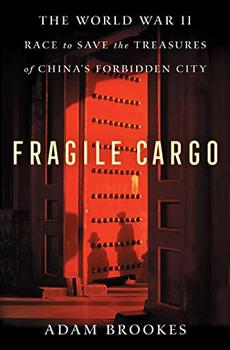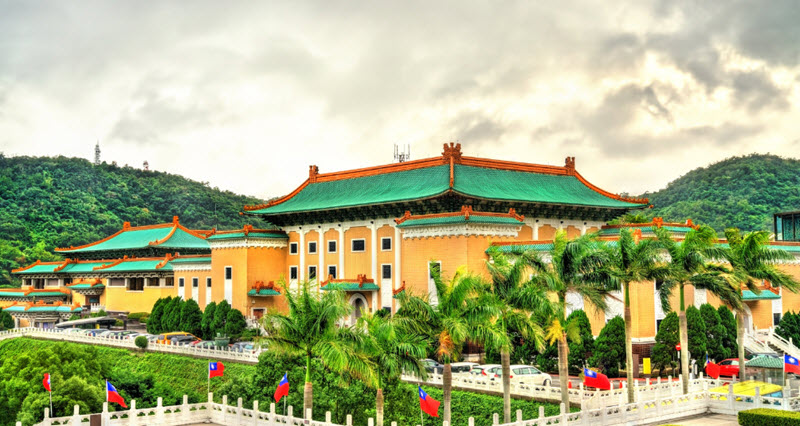Summary | Excerpt | Reviews | Beyond the Book | Read-Alikes | Genres & Themes | Author Bio

The World War II Race to Save the Treasures of China's Forbidden City
by Adam BrookesThis article relates to Fragile Cargo
 At the end of Fragile Cargo, Adam Brookes' excellent history about how China's cultural treasures were protected during World War II, the author informs his readers that the finest items in the imperial collection were moved to Taipan, Taiwan. They remain there to this day, an ongoing point of contention between Taiwan and China.
At the end of Fragile Cargo, Adam Brookes' excellent history about how China's cultural treasures were protected during World War II, the author informs his readers that the finest items in the imperial collection were moved to Taipan, Taiwan. They remain there to this day, an ongoing point of contention between Taiwan and China.
During the first half of the 20th century, China underwent massive cultural and political changes. The country had been ruled by emperors for millennia, but revolt and colonization by Western countries dramatically weakened imperial powers. In 1912, Nationalist revolutionaries forced the last emperor to abdicate, and the Republic of China was born. The new government decided to make the vast imperial grounds of the Forbidden City in Beijing into a museum that all could enjoy, and the Palace Museum was established in 1925. It was immensely popular; 50,000 people visited in the first two days it was open; and it stayed open even during the early years of the communist uprising in 1927 which embroiled China in civil war; but it was forced to close its doors and evacuate its most valuable pieces ahead of the Japanese invasion in 1931.
The civil war was mostly put on pause during WWII, but after Japanese forces were expelled in 1945, fighting broke out again. In 1949, knowing that the Chinese Communist Party was gaining the upper hand, the Nationalists sent the rarest objects from the Palace Museum to Taiwan (which had been held by Japan from 1895 until the end of WWII when it was returned to Chinese control). The following year, the Nationalist government fled to Taiwan, leaving the Communists in control of China, which was officially named the People's Republic of China. Meanwhile, in Taiwan, the Nationalist government formed the Republic of China. The Palace Museum treasures remained stored in a warehouse in Taiwan until the Taiwanese government received a grant from the United States to create a museum to house the artifacts; in 1965 the National Palace Museum in Taipei was completed.
Both the museum in Beijing and the one in Taipei continue to draw crowds today, but they're very different. The Palace Museum in Beijing comprises what used to be the imperial grounds, and consequently most of it is outside, covering 180 acres (a little under a third of a square mile). The medieval main complex was constructed from 1406 to 1420 CE, and it's the largest imperial palace in the world. While it continues to house almost two million artifacts, its emphasis is more on Chinese culture and the architecture of the Forbidden City than on the items in the collection. Over 19 million people visited the Palace Museum in 2019 alone.
The National Palace Museum, in contrast, was designed specifically to showcase the art removed from the Forbidden City as well as other pieces acquired over the decades. It highlights the objects themselves, using them as a way to showcase Chinese culture and history. Although it possesses 700,000 items, only about 0.2% of them can be shown at any one time due to limited space, so pieces are rotated in and out frequently. Some three million people visit the museum annually.
For decades the ownership of the collection in Taiwan has been hotly contested. Very simply, both the Nationalist government and the Communist government each felt that they represented the "true" China, and that the other was illegitimate; consequently, each believed the cultural antiquities rightfully belonged in their care. This has started to change recently, as some inside Taiwan have begun advocating for the artifacts to be returned to the Palace Museum. Their argument is that if objects worldwide are being repatriated to their countries of origin, the items taken from the Palace Museum collection rightfully belong in Beijing. The Communist government, however, still regards Taiwan as part of China, and therefore sees no need to repatriate the artifacts – they're already on Chinese soil, in their opinion. According to the Taipei Times, the Chinese Communist Party believes the fact that Taiwan retains these items of Chinese culture "shows that Taiwan stands united with China in proclaiming Chinese culture and proves the party's oft-stated point that "blood is thicker than water.'" For their part, the Taiwanese government shows no inclination to return the items to the mainland and is rumored to be making plans to relocate them to Japan or the United States should war break out (something museum authorities deny).
The National Palace Museum, Taipei; courtesy of Canva
Filed under Music and the Arts
![]() This "beyond the book article" relates to Fragile Cargo. It originally ran in April 2023 and has been updated for the
October 2023 paperback edition.
Go to magazine.
This "beyond the book article" relates to Fragile Cargo. It originally ran in April 2023 and has been updated for the
October 2023 paperback edition.
Go to magazine.
Your guide toexceptional books
BookBrowse seeks out and recommends the best in contemporary fiction and nonfiction—books that not only engage and entertain but also deepen our understanding of ourselves and the world around us.